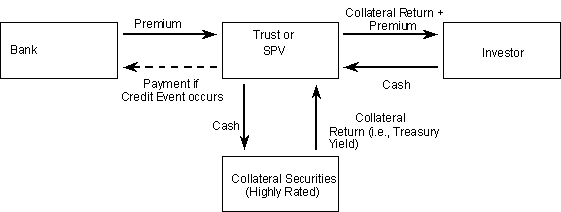
Personal Website of R.Kannan
Learning Circle - Trading in Derivatives
Credit Linked Notes

Personal Website of R.Kannan |
| Home | View Table of Contents | Feedback |
Back to First-Page to View Table of Contents |
Credit Linked Notes 11. The Credit-Linked Note (CLN) market is one of the fastest growing areas in the credit derivatives sector. It is, a combination of a regular note (bond or deposit) and a credit-option. Since it is a regular note with coupon, maturity and redemption, it is an on-balance sheet equivalent of a credit default swap. Under this structure, the coupon or price of the note is linked to the performance of a reference asset. It offers borrowers a hedge against credit risk and investors a higher yield for buying a credit exposure synthetically rather than buying it in the publicly traded debt. 12. Credit Linked Notes (CLNs), as seen in Figure 3, are created through a Special Purpose Vehicle (SPV), or trust, which is collateralized with AAA-rated securities. CLNs can also be issued directly by a bank or financial institution or non-banking finance company. Investors buy the securities from the trust (or issuing bank) that pays a fixed or floating coupon during the life of the note. At maturity, the investors receive par unless the referenced credit defaults or declares bankruptcy, in which case they receive an amount equal to the recovery rate. Here the investor is, in fact, selling the credit protection in exchange for higher yield on the note 
Credit Linked Note Structure 13. If the issuer is a trust, it enters into a default swap with a deal arranger. In the case of default, the trust pays the dealer par minus the recovery rate in exchange for an annual fee. This annual fee is passed on to the investors in the form of a higher yield on the notes. In this structure, the investors can obtain higher yield for taking the same risk as the holder of the underlying reference credit. The investor does, however, take the additional risk, albeit limited, of its exposure to the AAA-rated trust or issuing bank. The Credit-Linked Note allows a bank to lay off its credit exposure to a range of credits to other parties. |
|